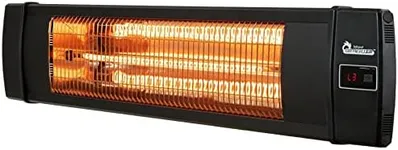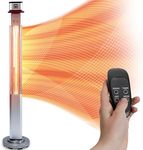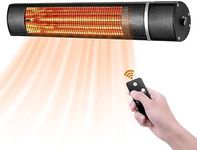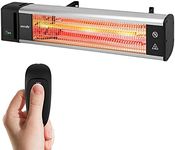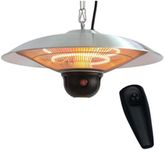Buying Guide for the Best Infrared Patio Heater
Choosing the right infrared patio heater can make your outdoor space comfortable and enjoyable, even when the temperature drops. The key is to match the heater’s features to your specific needs, such as the size of your patio, how often you’ll use it, and your preferences for installation and operation. Understanding the main specifications will help you make a confident and informed decision.Heating Power (Wattage)Heating power, measured in watts, tells you how much heat the patio heater can produce. This is important because it determines how large an area the heater can warm up. Lower wattage heaters (around 1000-1500W) are suitable for small patios or for spot heating, while medium wattage (2000-2500W) can cover medium-sized areas. High wattage heaters (3000W and above) are best for large patios or commercial spaces. To pick the right wattage, consider the size of your outdoor area and how many people you want to keep warm at once.
Mounting TypeInfrared patio heaters can be freestanding, wall-mounted, or ceiling-mounted. This spec is important because it affects where and how you can use the heater. Freestanding models are portable and easy to move, making them great for flexible setups. Wall-mounted and ceiling-mounted heaters save floor space and are ideal for permanent installations. Choose the mounting type based on your patio layout and whether you want a fixed or movable heater.
Heating Element TypeThe heating element is the part that generates infrared heat, and it can be made from different materials like quartz, carbon, or ceramic. This matters because it affects how quickly the heater warms up, how long it lasts, and the type of heat it produces. Quartz elements heat up fast and provide intense warmth, carbon elements offer a softer, more comfortable heat, and ceramic elements are durable and efficient. Think about whether you prefer quick, strong heat or a gentler, more even warmth when choosing the element type.
Weather Resistance (IP Rating)The IP (Ingress Protection) rating tells you how well the heater is protected against dust and water. This is crucial for outdoor use, as it ensures the heater can withstand rain and moisture. IPX4 means the heater is splash-proof, while IP65 or higher means it’s protected against heavy rain and dust. If your patio is exposed to the elements, look for a higher IP rating. For covered or sheltered areas, a lower rating may be sufficient.
Control OptionsControl options refer to how you operate the heater, such as manual switches, remote controls, or smart app integration. This is important for convenience and ease of use. Manual controls are simple and reliable, remotes let you adjust settings from a distance, and smart controls allow you to use your phone or voice commands. Choose the control method that fits your lifestyle and how you plan to use the heater.
Safety FeaturesSafety features like tip-over protection, overheat protection, and cool-touch exteriors are important for preventing accidents, especially if you have children or pets. Tip-over protection automatically shuts off the heater if it falls, overheat protection turns it off if it gets too hot, and cool-touch surfaces prevent burns. Consider which safety features are most important for your household and outdoor environment.
